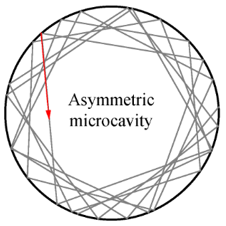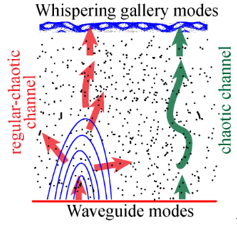Peking University, Oct. 31, 2019: Understanding the dynamic evolution of light is critical to manipulate photon transport in optical devices, and plays a pivotal role in the promotion of integrated photonic circuits. An asymmetric microcavity with boundary perturbations or deformations compared to a regular one, induces wave chaos that forms numerous channels to engineer photon transport, providing a superior platform to study dynamic evolution of light.
Very recently, a team led by Professor Xiao Yunfeng, in collaboration with his colleagues at Peking University in China and Jan Wiersig at Otto-von-Guericke-Universität Magdeburg in Germany, demonstrates experimentally the regular-orbit-engineered photon transport in an asymmetric microcavity. This work has been published in a recent issue of Physical Review Letters, and selected as Editors’ Suggestion (URL: https://doi.org/10.1103/PhysRevLett.123.173903).
Wave chaos, depicting the classical wave phenomena via quantum predictions, brings intriguing instructions to study fundamental photon transport processes and novel functionalized optical devices. For decades, multiple novel phenomena induced by wave chaos have been investigated, such as dynamical tunneling, non-Hermitian physics, and optical chirality. Recently, evolution of light in an optical chaotic cavity has not only attracted abundant research interests related to fundamental physics such as mode interactions, quality factor (Q) spoiling and turnstile transport, but also shed lights on efficient and broadband coupling.

Ray dynamics inside an asymmetric microcavity

Poincaré surface of the section introduced by ray dynamics and the schematics of evolution pathways
In this work, the researchers investigated the light evolution inside a deformed microcavity that is engineered by regular orbits in the phase space. The phase space is obtained by employing the ray model in the Poincaré surface of the section spanned by the azimuthal angle and the dimensionless angular momentum. Because different structures exist in the phase space, including the chaotic sea and regular orbits, the light evolution inside the cavity is quite sensitive to the excitation position in the phase space.
“When excitation positions in phase space are chosen at chaotic sea or regular periodic orbits respectively, two distinct pathways of light evolution happen. Once the light is excited in the chaotic sea, it transports along the chaotic channels, and eventually tunnels to whispering gallery modes. In comparison, when the light is excited in islands, it first tunnels to the chaotic sea before, and then transports to chaotic channels,” said Gu Yuzhong, a Master student at Peking University. “The simulation results show that the regular orbit will strongly suppress the efficiency of the photon transport process.”